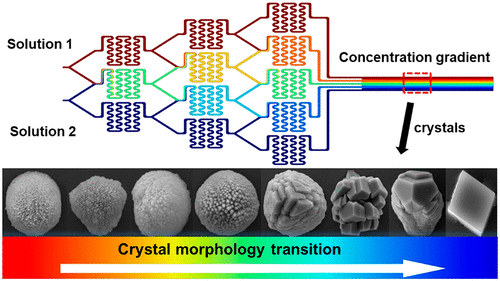当前位置:
X-MOL 学术
›
Cryst. Growth Des.
›
论文详情
Our official English website, www.x-mol.net, welcomes your
feedback! (Note: you will need to create a separate account there.)
Screening the Ion Compositions on Crystal Morphology Transitions by a Microfluidic Chip with a Well-Defined Concentration Gradient
Crystal Growth & Design ( IF 3.2 ) Pub Date : 2020-08-25 , DOI: 10.1021/acs.cgd.0c00926 Hong He 1 , Li Chen 2 , Zhijun Wang 3 , Lingjun Zhang 1 , Tingting Ge 1 , Xiao Xiang 1 , Shuxia Wang 1 , Yingzhou Huang 1 , Shunbo Li 2
Crystal Growth & Design ( IF 3.2 ) Pub Date : 2020-08-25 , DOI: 10.1021/acs.cgd.0c00926 Hong He 1 , Li Chen 2 , Zhijun Wang 3 , Lingjun Zhang 1 , Tingting Ge 1 , Xiao Xiang 1 , Shuxia Wang 1 , Yingzhou Huang 1 , Shunbo Li 2
Affiliation

|
The effects of organic and inorganic additives on crystal morphology have been extensively studied in various materials. However, the basic fundamentals behind the morphology control are still under debate due to the differences in experimental observations and lack of technical means to control the microenvironments where the crystal grows. Microfluidic technology with convenient operation and precise control of related parameters provides a unique tool for the investigation of crystallization processes on the micrometer and even nanometer scale. A concentration-gradient microfluidic chip was designed to screen the ion compositions to investigate the factors influencing the crystal morphology, and calcium carbonate was chosen for this study. Unexpectedly, the CO32–:Ca2+ ratio is discovered to induce a calcite morphology transition from regular rhombohedral to irregular rhombohedral and nanoparticle aggregations. In contrast, the morphology transition is believed to be caused by variations of the Mg:Ca ratio and supersaturation. The incorporation of different mole ratios of magnesium ions is also found to give different morphologies. The experimentally observed crystal morphology transition indicates that the crystal morphology is influenced by the CO32–:Ca2+ ratio when magnesium ions are present in the system. The proposed microfluidic method, providing an exquisite control of microenvironments during crystallization, can be applied in other materials to analyze the origin of unique morphologies. In addition, the discovery extends our understanding of the morphology control of biominerals.
中文翻译:

通过具有明确定义的浓度梯度的微流控芯片筛选晶体形态转变上的离子组成
在各种材料中,有机和无机添加剂对晶体形态的影响已得到广泛研究。然而,由于实验观察的差异以及缺乏控制晶体生长的微环境的技术手段,形态控制背后的基本原理仍在争论中。具有方便操作和相关参数精确控制的微流体技术为研究微米级甚至纳米级的结晶过程提供了独特的工具。设计浓度梯度微流控芯片以筛选离子组成,以研究影响晶体形态的因素,并选择碳酸钙进行此项研究。出乎意料的是,CO 3 2–:Ca 2+发现该比率可诱导方解石形态从规则的菱形体向不规则的菱形体和纳米颗粒聚集体转变。相比之下,形态转变被认为是由Mg:Ca比值和过饱和度的变化引起的。还发现掺入不同摩尔比的镁离子会产生不同的形态。实验观察到的晶体形态转变表明,该晶体形态受CO 3 2–:Ca 2+的影响系统中存在镁离子时的比率。所提出的微流体方法在结晶过程中提供了对微环境的精确控制,可用于其他材料中以分析独特形态的起源。此外,这一发现扩展了我们对生物矿物形态控制的理解。
更新日期:2020-10-07
中文翻译:

通过具有明确定义的浓度梯度的微流控芯片筛选晶体形态转变上的离子组成
在各种材料中,有机和无机添加剂对晶体形态的影响已得到广泛研究。然而,由于实验观察的差异以及缺乏控制晶体生长的微环境的技术手段,形态控制背后的基本原理仍在争论中。具有方便操作和相关参数精确控制的微流体技术为研究微米级甚至纳米级的结晶过程提供了独特的工具。设计浓度梯度微流控芯片以筛选离子组成,以研究影响晶体形态的因素,并选择碳酸钙进行此项研究。出乎意料的是,CO 3 2–:Ca 2+发现该比率可诱导方解石形态从规则的菱形体向不规则的菱形体和纳米颗粒聚集体转变。相比之下,形态转变被认为是由Mg:Ca比值和过饱和度的变化引起的。还发现掺入不同摩尔比的镁离子会产生不同的形态。实验观察到的晶体形态转变表明,该晶体形态受CO 3 2–:Ca 2+的影响系统中存在镁离子时的比率。所提出的微流体方法在结晶过程中提供了对微环境的精确控制,可用于其他材料中以分析独特形态的起源。此外,这一发现扩展了我们对生物矿物形态控制的理解。









































 京公网安备 11010802027423号
京公网安备 11010802027423号